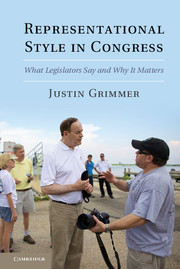Book contents
- Frontmatter
- Dedication
- Contents
- Acknowledgements
- 1 Representation Inside and Outside Congress
- 2 Representation and Evaluation on the Senator's Terms
- 3 Measuring Presentational Styles with Senate Press Releases
- 4 Measuring Presentational Styles in Thousands of Press Releases
- 5 The Types of Presentational Styles in the U.S. Senate
- 6 The Electoral Connection's Effect on Senators' Presentational Styles
- 7 The Correspondence between Senators' Work in Washington and Presentational Styles
- 8 Why Presentational Styles Matter for Dyadic Representation
- 9 Why Presentational Styles Matter for Collective Representation
- 10 Presentational Styles and Representation
- Methods Appendix
- Bibliography
- Index
10 - Presentational Styles and Representation
Published online by Cambridge University Press: 18 December 2013
- Frontmatter
- Dedication
- Contents
- Acknowledgements
- 1 Representation Inside and Outside Congress
- 2 Representation and Evaluation on the Senator's Terms
- 3 Measuring Presentational Styles with Senate Press Releases
- 4 Measuring Presentational Styles in Thousands of Press Releases
- 5 The Types of Presentational Styles in the U.S. Senate
- 6 The Electoral Connection's Effect on Senators' Presentational Styles
- 7 The Correspondence between Senators' Work in Washington and Presentational Styles
- 8 Why Presentational Styles Matter for Dyadic Representation
- 9 Why Presentational Styles Matter for Collective Representation
- 10 Presentational Styles and Representation
- Methods Appendix
- Bibliography
- Index
Summary
As I detailed in Chapters 3 and 4, Minnesota's freshman senator – Amy Klobuchar (D-MN) – had a busy first week in Congress. She not only had to decide what work to do, but she also had to decide how to present that work to constituents: how to define her representational style to constituents. Ninety-nine other senators faced the same choice when they began their Senate careers, but each faced different circumstances. Every member of the Senate had to consider what votes to explain, what policy work to publicize, and what spending to claim credit for securing.
This book has demonstrated the far-reaching consequences of these decisions for representation. I have shown how senators construct presentational styles to affect constituents' impressions of their senators' representational styles: the broad set of activities that representatives perform while in Washington. And I show that the contents of senators' presentational styles have far-reaching consequences for both dyadic and collective representation. They affect dyadic representation by influencing how constituents evaluate their representative. They affect collective representation by distorting debates, causing ideological extremists to dominate.
Together my findings contribute to a broad literature on representation. This literature tends to emphasize ideological representation while neglecting how legislators shape how their work is evaluated by constituents. But focusing on ideological representation alone neglects the role legislators play in influencing how their actions are evaluated by constituents. Recognizing this potential for influence offers new interpretations for long-standing findings in the study of ideological representation.
Information
- Type
- Chapter
- Information
- Representational Style in CongressWhat Legislators Say and Why It Matters, pp. 163 - 170Publisher: Cambridge University PressPrint publication year: 2013
